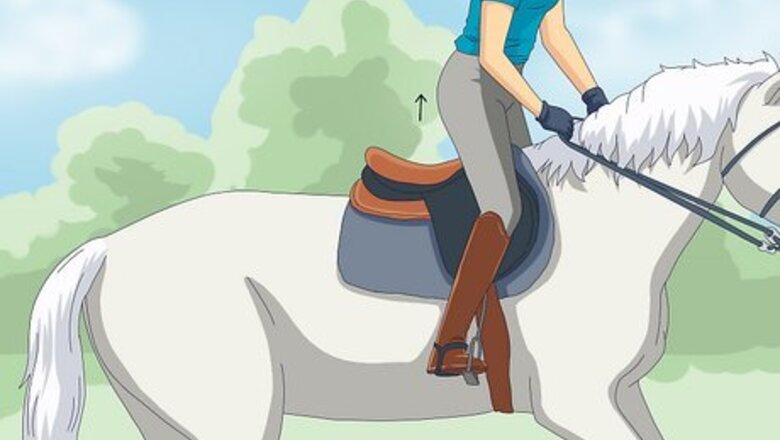
views
Maintaining Good Posture
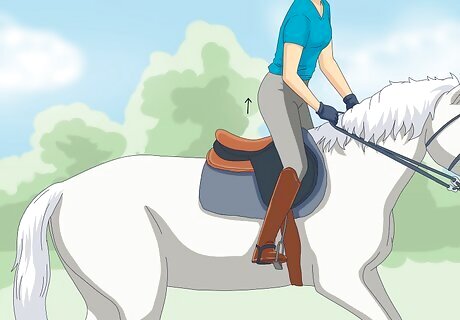
Ride as though you’re standing up, not sitting. Imagine that the horse suddenly winks out of existence from underneath you. Ride so that you would immediately land on your feet in a standing position if this were to happen. Ask a spotter to watch you ride and correct your posture as you go. Aim to maintain an unbroken line from your ear, through your shoulder and hip, and all the way down to your heel when viewed from the side. Although this form is considered ideal, the exception would be if you need to adjust your stirrups to alleviate strain in your knees.
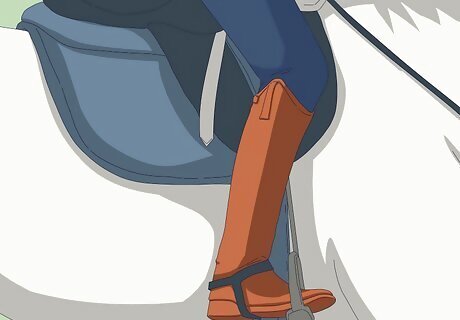
Hug the horse with your legs. Although the horse’s body will force your upper legs to stick out to your sides, resist the urge to follow through with your lower legs. Don’t stick your whole leg out to the side. Keep your lower legs close enough to the horse’s body to maintain contact. Ask a spotter to watch you as you ride straight toward them. Have them alert you whenever you start to straighten your legs to the side. Exerting pressure downward into the stirrups and out to your sides can lead to ankle and knee pain.
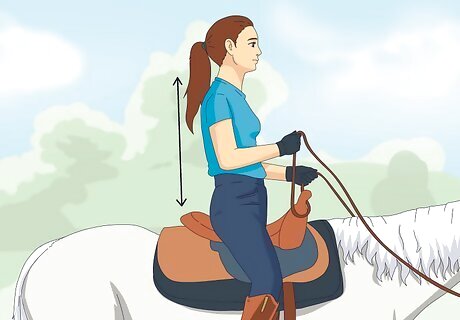
Avoid arching your back. Sit up straight to keep a straight line running from ear to shoulder to hip. However, be careful not to overdo it by arching backward. Stay seated on the seat-bones on your butt. Arching your back causes your weight to shift forward, which means you’ll be landing on your tender bits instead of the bones in your butt as you bounce in the saddle. Being able to sit up straight without having to think about it is an important reason to strengthen your core both on and off the horse. This will prevent you from tensing up as you try to maintain posture. In the meantime, focus on drawing your bellybutton in toward your spine. Concentrate only on the muscles required for this. This will help keep your back relaxed as you ride.
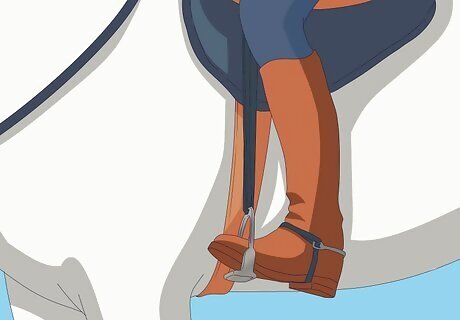
Point your toes slightly outward. Disregard outdated instructions about pointing your toes straight ahead of you. Avoid the unnecessary stress that this places on your joints. Instead, angle your feet so that each is pointing away from the horse by just a smidge. As you do, keep the balls of your feet in the stirrup. Stop when the weight of each foot feels evenly distributed across the entire stirrup. This may be referred to as “pronating” by instructors. It's always best to wear boots with a small heel, so your feet can stay steady in the stirrups.
Strengthening Your Core
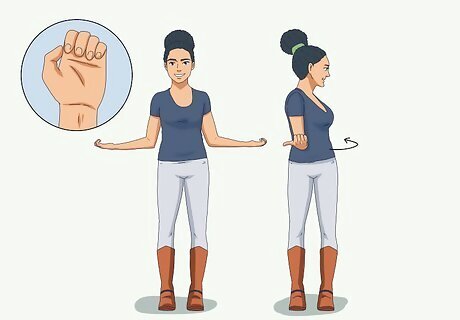
Tuck, twist, turn. To start, stand up with your feet placed under your hips. Curl your fingers into loose fists with your thumbs sticking out. Keep your upper arms and elbows tucked to your sides. Raise your forearms to either side of you, with your palms facing up and your thumbs pointing behind you. Then: Bend your knees a little bit while tucking your tailbone inward. Keeping your feet in place, turn your upper torso to one side, twisting from your waist. Stop once your rear arm is pointed directly behind your butt. Twist back to your original position, again using the muscles in your waist. Perform the same movements on your other side for one rep.
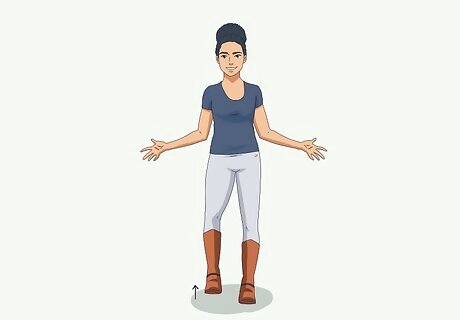
Balance your core. To begin, stand with your feet placed a hand’s length apart. Keeping your upper arms and elbow tucked to your sides, raise your forearms straight out to either side with your palms facing in front of you. Spread your fingers wide to keep the muscles in your hands, arms, and back active (think “jazz hands”). Next: Raise one foot slightly off the ground. Keep your other leg’s knee slightly bent to better absorb your body weight. Rotate your raised foot until your toes point inward. Focus on your heel as it directs each movement, not your toes. Lower your foot and repeat the exercise with your other foot. Concentrate on your heels throughout to keep your core muscles engaged.
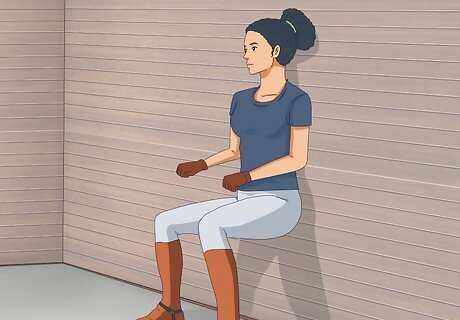
Clap your hands. Get into position by standing back against a wall. Set your feet a hand’s length apart. Bend your knees as you do so your entire back makes contact with the wall. Tuck your upper arms and elbows into your side. Raise your forearms straight out to either side. Now: Sweep your forearms in toward each to clap your hands in front of you. As you do, keep your forearms perpendicular to your body. Once your hands have clapped, fold your fingers with your thumbs on top to mimic holding a rein. Bring your forearms back to starting position and repeat.
Gearing Up
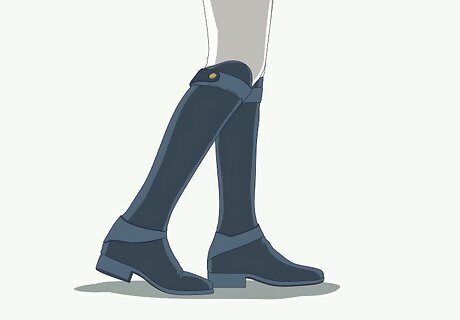
Wear the right boots. Make sure they are tall enough to cover your ankles, which will keep them supported as you ride. Opt for a heel between 1 and 1 ½ inches to prevent your feet from spilling out of the stirrups. At the same time, avoid boots with heavy treads, which may cause your feet to become stuck in the stirrups, preventing a quick dismount in an emergency. Do not wear the following: Waffle treads Thick treads Hiking boots Winter boots Sneakers Sandals and flip-flops
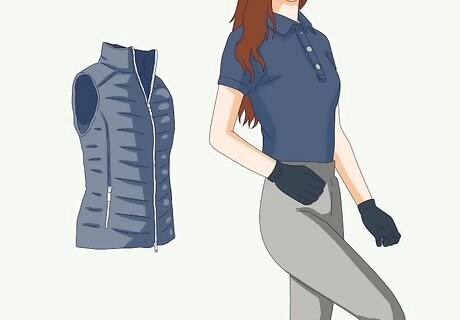
Choose flexible clothing. For upstairs, stick to sweatshirts and T-shirts so your arms and upper torso aren’t restricted. In colder weather, opt for layers topped with a vest to keep your arms mobile. Downstairs, favor tights, jeans, and sweatpants. Be sure that they are flexible enough to allow your legs to move freely. Although you want your clothes to allow you freedom of movement, they should still be form-fitting or close to it. Loose clothing may become caught on your equipment or surroundings, which can lead to injury. Don’t wear pants that easily become twisted or bunched up as you move in them. Don't wear shorts when you go riding, or else your legs will chafe and hurt a lot.
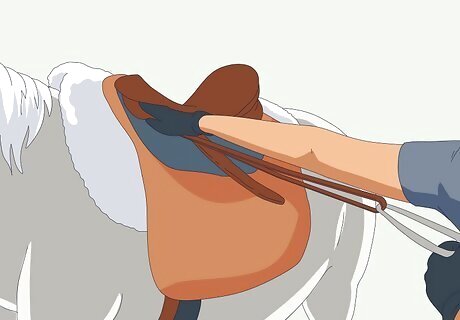
Adjust your stirrups’ length. If your knees feel strained as you ride, play with the length to find one that helps alleviate the pain. Length is a matter of personal preference, so don’t feel obligated to copy a more experienced rider if their preferred length causes you pain. As you shorten and lengthen your stirrups, remember: You want to find a leg position that allows your legs to comfortably exert enough force into the stirrups to raise your butt a little. This prevents you from sitting with all of your body weight on the saddle, which will make your butt sore. Try placing your stirrup so your knees are bent at about a 45°angle for a comfortable fit. If your stirrups are too short, your knees will be too bent, which can cause some knee pain. If the stirrups are too long, your legs are too straight, and that will also put strain on your legs.
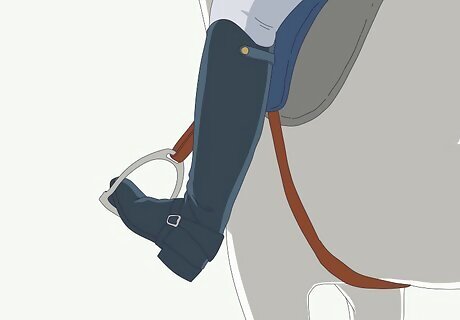
Use a saddle whose stirrups swing freely. Whenever you go downhill, let your feet follow gravity. Straighten your legs in a forward direction as you descend. Do this to lessen the amount of pressure that your knees have to bear. Only use loose stirrups to straighten your legs forward. Sticking them out to your sides as if you were doing a split causes your muscles to tense up all over. In addition, choose a saddle that's the right size for you.
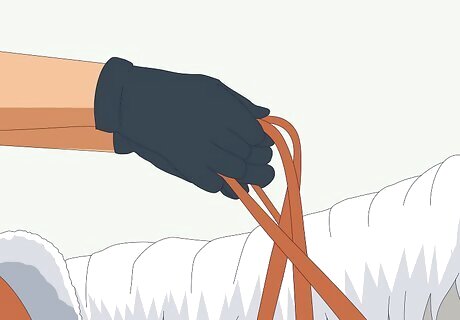
Use light reins. Expect your hands to grow numb or sore from having to hold the reins over the course of long rides. If possible, avoid using a thick rein made of rope. Instead, use a thinner rein made of leather, which is usually lighter and less taxing in the long run. Also, wear gloves to prevent blisters.
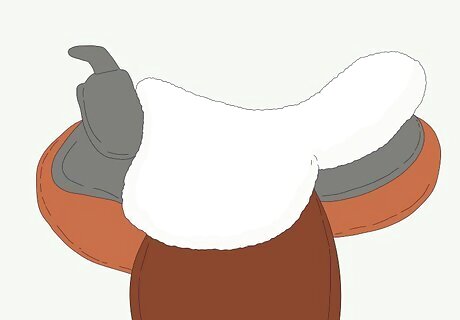
Sit on a “seat saver.” Soften the blows that your butt has to endure from sitting on a hard saddle. Cover the saddle with a seat saver whose cushioning absorbs most of the shock before it reaches your rear. Store your seat saver somewhere warm and dry after your ride. Keep in mind that some seat savers’ material (especially foam) may act like a sponge if it gets wet. This means it will become just as hard as your saddle if temperatures dip below freezing.


















Comments
0 comment